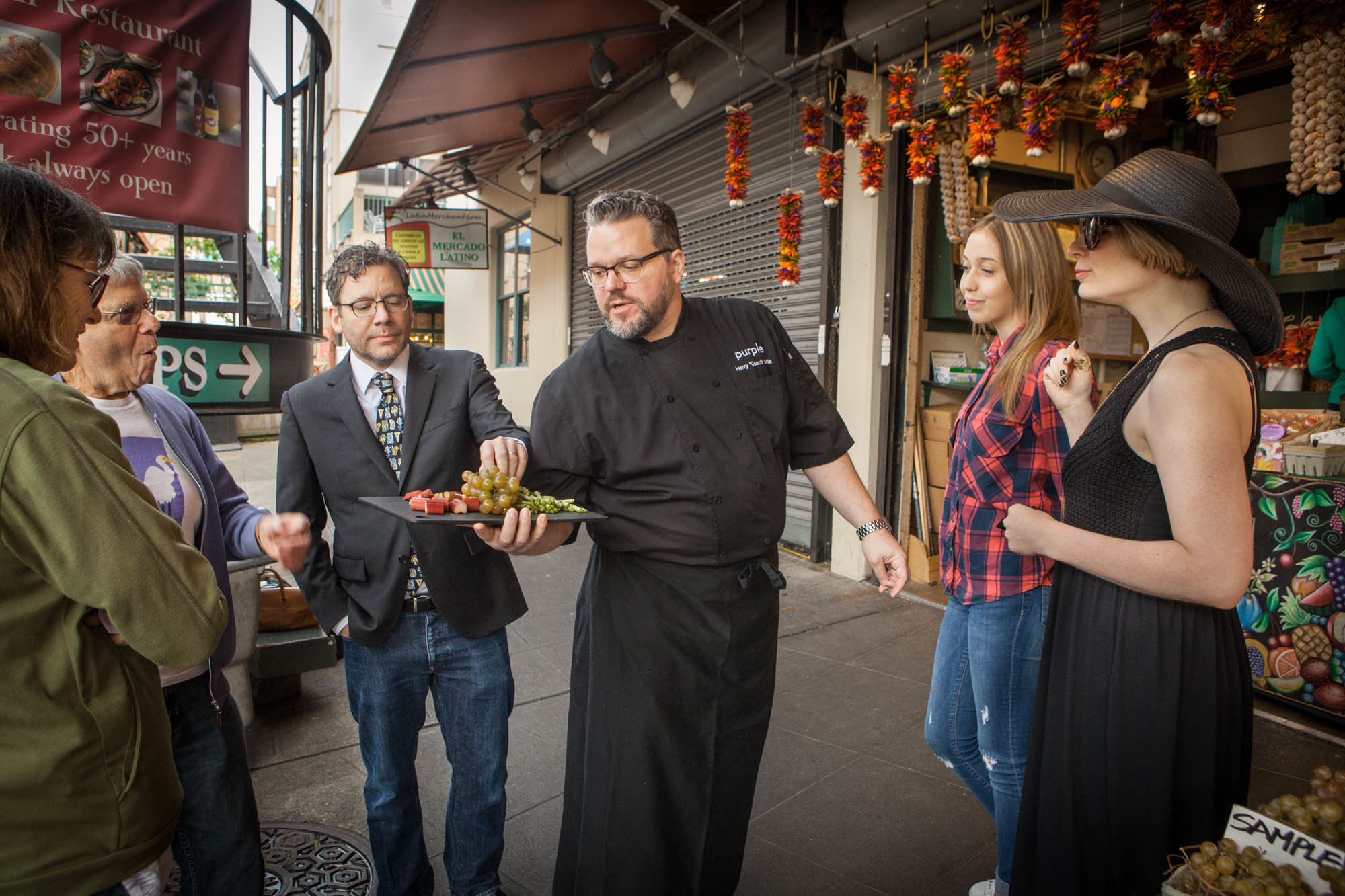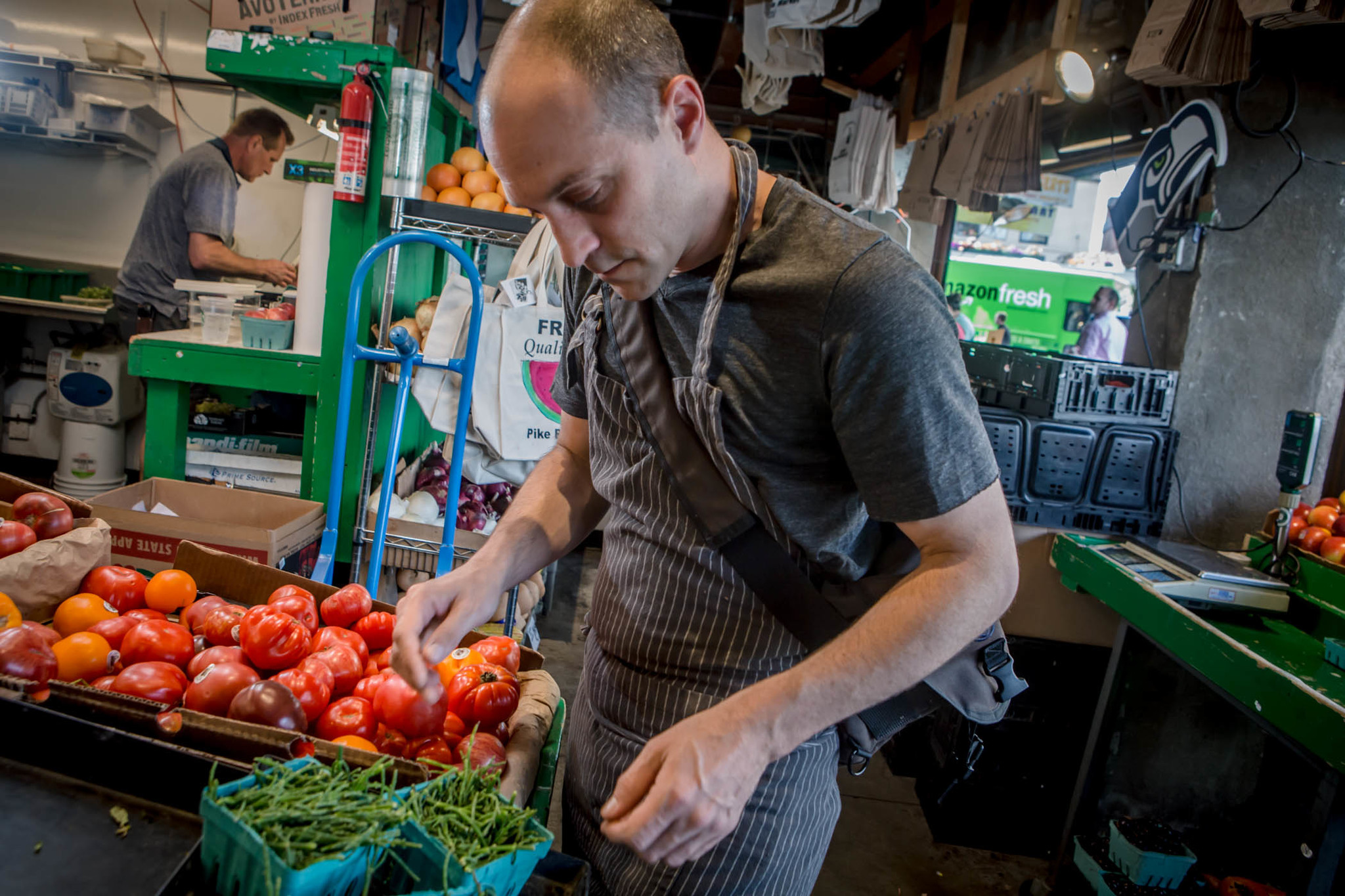Our May edition of Road to Voracious took us to India and back with Chef Bella Sangar’s seasonal creations. But the fun is just beginning – those who opted in for June’s sold out tour will reap the benefits of wine pairing with each of the dishes they create. For Chef Harry Mills, a good wine is as essential to a dish as the fork you eat it with.
A huge part of your menu creation as the Executive Chef at Purple Seattle involves thinking about wine pairings. What is it about that relationship that is so beguiling, and do you always start with the food first? It’s about: 1+ 1 can equal three. There is something more when you find that right beverage. Something that’s more than the sum of its parts. It’s really cool when that happens; when with every sip you want to take a bite, and with every bite you want to take a sip. For a regular menu, we create dishes with wine in mind, but the food comes first. We just got our last delivery of nettles, so we can only do the nettle and artichoke pizza for another week or so. There are constant tweaks to the menu like that, but there are also 7-10 wine changes a year. Our sommelier uses the 95 glass pours we have to pair with the dishes. We can usually come up with some that are pretty spot-on. But we might lose a particular wine, and need to change the pairing even if the dish doesn’t change.
For your Road to Voracious Class at the Atrium Kitchen, do you have any dishes or ingredients in mind that you want to cook with, or any exceptional wines you’re hoping to showcase? Early June is like that perfect peak spring vegetable time of year, so that will be in play whether it’s snap peas, asparagus or something more obscure. In addition to that, I’ll probably grab some wild King salmon. It’s just starting to run now, and at this time of year it’s so luscious, so marbled, and if cooked properly has that crème brûlée texture, that custardy interior, to it. One of my favorite things about Pacific Northwest cooking is that prized, beautiful salmon. Certainly the King from Alaska, The Columbia River or out on the Peninsula. It’s like, ‘a Pike Place Market class on June 4th?’We have an obligation to do salmon. As for wine, probably some Oregon Pinot Noir and French Burgundy. “What grows together goes together” is our underpinning philosophy. It usually works, though it can be colossally bad too! But King salmon and Oregon Pinot is such a slam dunk.
Participants will walk the market with you to shop for the ingredients. Tell us about some of the places you like to visit there? I love Sosio’s Fruit & Produce. They always have interesting wild mushrooms, the “holy shit” peaches. Their staff really tends to understand produce. They clearly have a doctrine with how they buy produce that is obvious to me as a chef. You won’t see crappy Roma tomatoes sitting out in the middle of January. They also have local product that I don’t typically see at retail, like Lacinato kale from local farmers or red-veined sorrel, though it might only be there for two days. And then there’s DeLaurenti. It’s one of the best specialty markets in the country. They have stuff you really want to try. If you want to just have a cured meat and cheese experience on, say, a Sunday afternoon, you can go crazy in there. Don and Joe’s Meats is incredible too. You can get things like rabbit and squab that are hard to find retail.
When you’re not shopping for work, tell us your favorite place to get a snack in the market? I’m not a crazy sweet person, but the little donuts guy. The cinnamon sugar ones when they shake them up in the bag. That to me is like a classic stop in the market. Grab a few guys and nibble on the way through.
It’s spring, and fresh produce like peas and cherries and asparagus are emerging. What kind of wines should people be considering as they move from the heavier foods of winter to the lighter tastes of this season? We’ll do a lot more white and rosés over burgundy. I like white wine all year; it’s so much easier to pair with food because it has more fruit and herbaceous-ness. One of the things I like about summer is rosé. I know it’s super trendy now, but it’s wonderful and you have serious wine makers like Bob Betz [in Woodinville] making it. The rosés made in the French Rhone Valley are making it to the states, too. It goes well with fish, and strawberries in a savory approach, like with duck breast. In summer and spring, Pinot Noir also comes to mind for me and Cru Beaujolais, not Beaujolais Nouveau. It grows just barely south of Burgundy, so it shares some similarities and is great for spring/summer dishes when you want a red wine that doesn’t blow the back of your head out. Definitely less oak on the whites, so really super rich Chardonnays will give way to Sancerres and Sauvignon Blancs because they are lighter on the palate and have less alcohol. I like to think of it as have a little more wine with a little less alcohol. Lighter bodied, less alcohol, more acid, and more refreshment.
What is the single most important thing people will learn in this class? A goal of our restaurant for a decade has been “get over yourself.” Wine is not about intimidating guests. It’s about having food and wine together every day. I was in France last year and I’m always struck by their airy, light approach to enjoying wine with food. No one is pulling out their Wine Spectator app. If you keep a certain number of wines and a certain number of items in your pantry you can come up with a pairing every day. So for class, you’ll get some basic tips on how to diminish your apprehension about something that shouldn’t be so academic. Get out a bottle of wine. If it’s a miss put the cork back in and get something else out, or try something different the next time you go shopping. Explore, it’s supposed to be fun and pleasurable, not a religion. We’re going to have fun. We like to goof off. It’s a good way to spend a Saturday afternoon.
Join us on the Road to Voracious, once a month at Pike Place Market’s Atrium Kitchen. Space is limited, so grab your ticket here.








